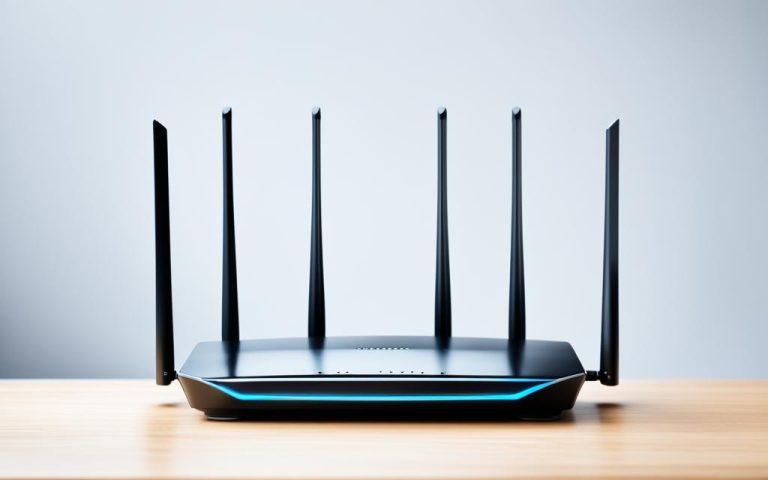Enterprise WLAN deployment plays a critical role in today’s business landscape, providing reliable wireless connectivity for employees, customers, and guests. As an IT manager, it is essential to understand the strategies involved in deploying a secure and efficient wireless network.
With the rise of remote work, the demand for robust wireless networks has never been greater. However, deploying an enterprise WLAN involves careful planning, consideration of security risks, and the implementation of effective strategies.
In this comprehensive guide, we will explore the best practices and strategies that IT managers can leverage for a successful enterprise WLAN deployment. From network security measures to site surveys and configuring wireless access points, we will cover all the critical aspects of building a robust and reliable wireless network.
Enterprise Network Security Risks and Threats
Enterprise wireless networks face various security threats due to their inherent vulnerabilities. Wireless networks lack robust security tools and are susceptible to infiltration through wireless access points. Attackers can gain unauthorized access to an organization’s network and conduct malicious activities, compromising network connectivity and system stability. These attacks include packet sniffing, rogue access points, password theft, and man-in-the-middle attacks. Wireless networks also face the risk of interference from other wireless devices and potential attacks from neighboring organizations’ networks. It is essential for IT managers to understand these risks and take proactive measures to mitigate them through proper network security protocols and best practices.
To ensure a secure enterprise network, IT managers need to be aware of the potential risks and threats associated with wireless networks. By understanding these vulnerabilities, they can implement appropriate security measures and strategies to protect their organization’s network infrastructure.
Common Security Risks and Threats
- Packet sniffing: Attackers can capture and analyze network traffic, potentially exposing sensitive information.
- Rogue access points: Unauthorized or malicious access points can be set up within the network, allowing attackers to gain unauthorized access and carry out attacks.
- Password theft: Weak or compromised passwords can be easily stolen, granting unauthorized access to the network.
- Man-in-the-middle attacks: Attackers intercept and potentially alter communication between network users, enabling them to eavesdrop or perform unauthorized actions.
- Interference from other devices: Other wireless devices operating in the same frequency range can interfere with the network’s performance and security.
- Attacks from neighboring networks: Cybercriminals can exploit vulnerabilities in neighboring networks to launch attacks on the organization’s wireless network.
These risks and threats highlight the importance of implementing robust security measures to protect enterprise wireless networks. By adopting best practices, such as strong encryption protocols, regular security updates, and network monitoring, organizations can mitigate the risks and ensure the integrity and confidentiality of their network data.
“Wireless networks lack robust security tools and are susceptible to infiltration through wireless access points. It is essential for IT managers to understand these risks and take proactive measures to mitigate them through proper network security protocols and best practices.”
Protecting Against Enterprise Network Security Risks
To protect against the risks and threats mentioned above, IT managers must adopt the following security measures:
- Deploying a wireless intrusion detection system (WIDS) and a wireless intrusion prevention system (WIPS) to detect and prevent unauthorized access and malicious activities.
- Implementing strong authentication and encryption protocols, such as WPA2-Enterprise or WPA3, to secure network communication.
- Regularly updating and patching network equipment to address known vulnerabilities.
- Creating and enforcing strong password policies to prevent password theft.
- Monitoring network traffic and implementing measures to detect and respond to suspicious activities.
- Using network segmentation to limit the impact of potential attacks.
- Educating employees about best practices for wireless network security, including the risks of connecting to unsecured or unknown wireless networks.
By implementing these security measures, organizations can better protect their enterprise networks from potential risks and threats, ensuring the confidentiality, integrity, and availability of their network resources.
Minimizing Risks to Enterprise Wi-Fi Networks
IT managers play a critical role in minimizing risks to enterprise Wi-Fi networks by implementing recommended best practices. By following these strategies, organizations can enhance the security of their Wi-Fi networks and protect against potential threats.
Deploying Wireless Intrusion Detection and Prevention Systems
One essential step in minimizing risks is to deploy a wireless intrusion detection system (WIDS) and a wireless intrusion prevention system (WIPS) on every network. These systems continuously monitor network traffic, detect unauthorized devices, and automatically deploy countermeasures to mitigate identified threats.
Keeping Equipment Secure and Up-to-Date
Another crucial measure is to ensure that all network equipment is free from vulnerabilities. Regularly updating software and firmware helps to address any known security vulnerabilities. IT managers should also securely configure equipment by disabling unused features, enforcing strong passwords, and applying appropriate encryption settings.
Implementing Multi-Factor Authentication
Enhancing network security involves implementing multi-factor authentication, which adds an extra layer of protection by requiring multiple forms of credentials for user authentication. This approach significantly reduces the risk of unauthorized access to the network.
Utilizing Extensible Authentication Protocol-Transport Layer Security (EAP-TLS) Certificate-based Methods
An effective method to strengthen network security is to use EAP-TLS certificate-based methods. This authentication protocol requires clients to present a valid certificate before accessing the network, ensuring that only authorized devices can connect.
Establishing a Separate Guest Wi-Fi Network
A dedicated guest Wi-Fi network is important for minimizing risks to enterprise Wi-Fi networks. By segregating guest traffic from the main network, potential threats are contained, reducing the risk of unauthorized access and potential security breaches.
By implementing these best practices, IT managers can significantly minimize risks to enterprise Wi-Fi networks, ensuring the security and reliability of wireless connectivity for their organizations.

Types of Site Surveys for WLAN Deployment
Site surveys play a crucial role in WLAN deployment as they assess the radio frequency (RF) behavior in a specific environment. By conducting site surveys, IT managers can gather valuable data to ensure optimal performance and coverage for their wireless networks. There are three primary types of site surveys that serve different purposes: passive, active, and predictive.
Passive Surveys
Passive surveys are performed in a listen-only mode, making them useful for identifying rogue devices and assessing RF coverage. During a passive survey, the survey client only listens to the RF signals in the environment without actively associating with any access points (APs). This type of survey helps IT managers understand the existing RF landscape and identify any potential interference or coverage issues.
Active Surveys
Active surveys require the survey client to associate with the access points (APs) used throughout the survey. This active association enables the collection of more detailed information for design purposes. IT managers can measure various metrics like signal strength, throughput, and roaming performance to fine-tune the network’s configuration and optimize its performance. Active surveys are particularly useful during the initial design and planning stages of WLAN deployment.
Predictive Surveys
Predictive surveys utilize specialized software programs to perform AP placements based on RF algorithms, eliminating the need for field measurements. These surveys take into account factors such as building layouts, wall materials, and potential sources of interference. IT managers can input the desired coverage requirements and network parameters into the software, which then generates a predictive model for AP placement. Predictive surveys are effective for pre-deployment planning and provide a good starting point for WLAN design.
A well-planned combination of passive, active, and predictive surveys can provide comprehensive insights into the RF behavior and help IT managers make informed decisions during WLAN deployment.
Here is a comparison of the three types of site surveys:
| Survey Type | Advantages |
|---|---|
| Passive Survey |
|
| Active Survey |
|
| Predictive Survey |
|
Choosing the appropriate survey type depends on the specific deployment requirements and goals. The combination of these site surveys ensures a comprehensive understanding of the RF environment and facilitates the successful deployment of a robust and reliable WLAN.
Best Practices for WLAN Site Surveys
To ensure a successful WLAN site survey, IT managers should follow best practices. These practices encompass various steps and considerations that contribute to accurate and reliable survey results.
Initial Walkthrough and Zone Identification
Begin the site survey process with an initial walkthrough of the deployment area. This step helps identify any difficult zones and confirms the areas that need to be surveyed. By understanding the environment and its unique characteristics, IT managers can plan and execute the survey more effectively.
Choosing the Right Survey Models
Selecting appropriate survey models is crucial for capturing the necessary data based on the specific deployment requirements. Consider using different survey models, such as data, voice, or location, to gather comprehensive information about the network’s performance and coverage. By tailoring the survey models to the deployment characteristics, IT managers can obtain more accurate insights.
Utilizing Effective Survey Tools
The use of reliable survey tools enhances the efficiency and accuracy of the site survey. Consider utilizing the following tools:
- – Digital floor plans: Create digital floor plans to visualize the network layout and aid in identifying potential coverage areas and obstacles.
- – Spectrum analysis tools: These tools help analyze the RF spectrum and detect any interference that might affect the WLAN’s performance.
- – Professional survey tools: Leverage professional survey tools that provide advanced features and functionalities, allowing for comprehensive data collection and analysis.
Considering Client Device Characteristics
When conducting a WLAN site survey, it is essential to take into account the characteristics of the client devices that will be deployed. Consider factors such as power requirements, cable considerations, and outdoor grounding to ensure that the survey accurately represents the network’s performance in real-world scenarios.
Collaboration with Site Survey Providers
Collaborating with a reliable site survey provider can greatly benefit the survey process. These providers have the expertise and experience to conduct thorough surveys, ensuring accurate results. By leveraging their knowledge and capabilities, IT managers can minimize mistakes and obtain the most reliable survey data.
Efficient Calibration of Survey Maps
Accurate calibration of survey maps is crucial to obtaining reliable survey results. IT managers should ensure that survey maps are calibrated according to the specific survey tools being used. This calibration process involves calibrating the signal strength measurements, AP locations, and other relevant parameters.
By following these best practices, IT managers can conduct WLAN site surveys effectively, gathering accurate data and optimizing the deployment of their wireless networks.
Deploying and Configuring Wireless Access Points
To ensure a smooth deployment and optimal performance of wireless access points (APs), IT managers need to follow a set of best practices. By deploying and configuring APs correctly, organizations can minimize interference, enhance network security, and ensure seamless connectivity for users. Here are the key steps involved in the deployment and configuration process:
1. Specify Unique Channel Frequencies
One of the first steps in deploying APs is to specify unique channel frequencies for each AP. This helps reduce interference between APs and ensures optimal network performance. By assigning different channel frequencies, IT managers can minimize channel overlapping and improve overall signal quality.
2. Configure SSID and Encryption Standards
When configuring APs, IT managers need to set up the Service Set Identifier (SSID) or the wireless network name. Additionally, they should choose the appropriate encryption standards, such as WPA2 or WPA3, to ensure secure communication between APs and client devices.
3. Set Up IP Addresses, Subnet Masks, and DNS Names
To establish network connectivity, IT managers should assign unique IP addresses, subnet masks, and Domain Name System (DNS) names to each AP. This allows APs to communicate with other devices on the network and facilitates seamless data transmission.
4. Disable Built-in DHCP Service
If there is a separate Dynamic Host Configuration Protocol (DHCP) server on the network, IT managers should disable the built-in DHCP service on the APs. This prevents conflicts and ensures that IP addresses are assigned correctly by the central DHCP server.
5. Configure RADIUS Authentication
For authentication and accounting processes, IT managers should configure a unique Remote Authentication Dial-In User Service (RADIUS) shared secret for each AP. They should also specify the IP address of the RADIUS server, which acts as the central authentication server for wireless clients.
Best Practices for Deployment and Configuration
- Follow the manufacturer’s documentation and best practices for AP deployment and configuration.
- Regularly update the firmware of APs to ensure the latest features and security patches.
- Perform a site survey to identify the optimal locations for AP placement.
- Consider factors such as signal coverage, interference, and client density when positioning APs.
- Use spectrum analysis tools to identify and mitigate any potential interference sources.
- Implement proper cable management and grounding techniques to minimize signal degradation.
By following these guidelines, IT managers can ensure the successful deployment and configuration of wireless access points, enabling organizations to enjoy reliable and secure wireless connectivity.
Conclusion
Enterprise WLAN deployment requires careful planning, consideration of security risks, and adherence to best practices. By implementing proper network security protocols, such as deploying a wireless intrusion detection system (WIDS) and a wireless intrusion prevention system (WIPS), securing equipment, and establishing multi-factor authentication, IT managers can enhance the security of their enterprise Wi-Fi networks.
In addition to security measures, conducting site surveys, following best practices for WLAN site surveys, and accurately configuring wireless access points (APs) are crucial for optimal network performance and coverage. Site surveys help determine the RF behavior in a specific environment, allowing IT managers to make informed decisions about AP placement. Following best practices during site surveys, such as using proper survey models and tools, collaborating with survey providers, and calibrating survey maps, ensures accurate and reliable survey results.
By deploying and configuring wireless APs based on manufacturer’s documentation and best practices, IT managers can further optimize their enterprise WLAN deployment. Specifying unique channel frequencies, configuring necessary settings, and disabling DHCP services on APs when a separate DHCP server is available are essential steps to ensure proper functionality and connectivity. Configuring authentication and accounting processes through RADIUS settings also adds an extra layer of security.
With these strategies in place, IT managers can successfully deploy wireless networks tailored to their organization’s needs while safeguarding against security threats and ensuring reliable connectivity for users. A well-planned and secure enterprise WLAN deployment is a cornerstone of efficient and effective network connectivity within the organization.
FAQ
What is enterprise network security?
Enterprise network security involves protecting a network that connects systems, mainframes, and devices within an organization. It aims to safeguard against various security threats and ensure the confidentiality, integrity, and availability of network resources.
What are the unique security threats faced by wireless networks?
Wireless networks, also known as Wi-Fi, face unique security threats due to the lack of robust security tools commonly found in wired networks. These threats include packet sniffing, rogue access points, password theft, and man-in-the-middle attacks.
How can IT managers minimize risks to enterprise Wi-Fi networks?
IT managers can minimize risks by deploying a wireless intrusion detection system (WIDS) and a wireless intrusion prevention system (WIPS) on every network. They should also ensure equipment is free from vulnerabilities, securely configure equipment, and meet encryption requirements.
What are the types of site surveys for WLAN deployment?
There are three types of site surveys: passive, active, and predictive. Passive surveys are useful for identifying rogue devices and assessing RF coverage, while active surveys provide more detailed information for design purposes. Predictive surveys utilize software programs to perform AP placements based on RF algorithms.
What are the best practices for WLAN site surveys?
Best practices for WLAN site surveys include conducting an initial walkthrough of the deployment area, selecting the appropriate survey model, using tools like digital floor plans and spectrum analysis tools, and specifying client device characteristics. Collaborating with a site survey provider and calibrating survey maps are also important.
How should IT managers deploy and configure wireless access points?
IT managers should start by specifying unique channel frequencies for APs to reduce interference. They should then configure the SSID, encryption standards, IP addresses, subnet masks, DNS names, and other necessary settings. It’s important to disable the built-in DHCP service on APs if there is a separate DHCP server on the network and configure a unique RADIUS shared secret for each AP.




















One Comment